A
VISIT TO PORTUGAL
December
11-21, 2016
We stayed at Caiscais just south of Lisbon in the
luxurious
house of Connie Goldberg an international bridge player and Rui
Marques, a bridge
director who
works with Eitan, and they were wonderful hosts.
Caiscais is lovely port town with a river emptying into the sea by the lighthouse.
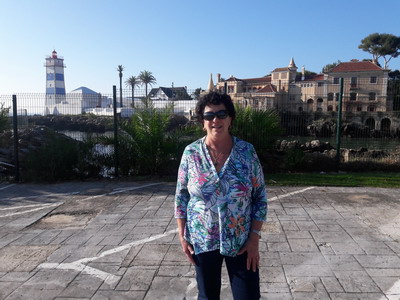
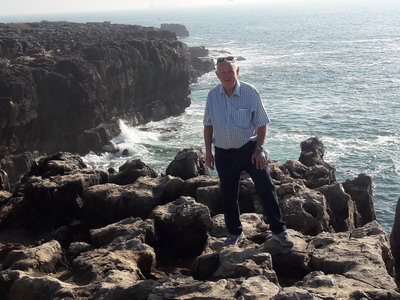
At Boca do Inferno, on a calm day, we watched as the Atlantic Ocean
crashed
against the rocks.
The previous night we had talked at length about cork and the modern
way they
prepare it: very thin against a strong material backing that is
waterproof,
stain-proof and very attractive. We were delighted to find a number of
stalls
by the site selling cork products, like hats, bags, and purses.
We then met Rui and Connie for lunch in town and enjoyed delicious
grilled dorado (denise)
fish at Rosa’s
Home Cooking. After lunch we drove through fashionable Estoril to Setubal. We stopped at the Igreja de Jesus church to explore manueline
decorations only to find the body of some-one in the church awaiting
the
funeral service. From pictures it seemed he was a famous actor. As the
church
filled up with people bearing flowers we admired the intricate manueline carving of ropes and columns carved
from three twisted strands.The
church walls were covered with blue tiles that formed religious
pictures, like paintings in other churches. We later found this to be
very common.
From there we drove to Sesimbra. The
fishing
village lies on a steep hillside with narrow roads and plenty of steps.
We sat
at a café by the waterside in the late afternoon and watched as boats
of all
sizes made their way to the marina as the sun was setting.
Fish in Portugal was plentiful although, like elsewhere, much of it is
farmed; crabs and calamari were also common.
We went for dinner and fado to O Faia in Lisbon in an area known for fado
restaurants The evening was long. After ordering each course the lights
were dimmed and the fado singer accompanied by two excellent
guitarists sang four long impassioned songs. Afterwards the food was
brought,
we ate and ordered the next course, receiving it after the next
fado
singer performed. This was repeated three times with different
singers
each time. Our main meal was served after 11 pm! We wished
we could have
understood the heartfelt words being sung and sometimes shouted.
We were impressed by the fine road system in Portugal; Rui told us that
the
system of highways connecting the main cities was funded by the EU. We were generally impressed by the drivers,
but that changed that evening after dinner. It seems that young
people like
to hang out and drink while standing in the cobbled streets in the
restaurant
district. Our taxi driver on the way
back had a unique way of driving. He put his foot on the pedal and
drove at
high speed along the narrow twisting streets crowded with the young
people
standing and drinking. He obviously relied on their jumping out of his
way. I
don’t know – I covered my eyes and crouched in the seat but Eitan
assured me
the driver didn’t manage to hit even one reveler.
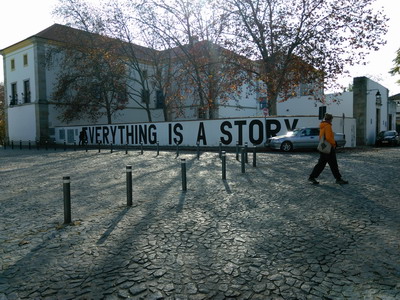
The next day we drove to Evora.
We
parked on a street and couldn't work out how to pay for parking.
Portuguese people generally speak English and are unfailingly helpful.
We were delighted to be told that the parking machine
didn’t work and we needn’t pay. We walked to the main square through
the old
Jewish quarter and even found one doorpost that had a place incised
into the
stone threshold for a mezuzah. We had coffee at Praca
do Giraldo, enjoying the winter sun and
the activity
in the main square. We walked towards the Palacio da Inquisicao
to find that the name had been changed to Fundacao
Eugenio de Almeida and instead of the original Inquisition table I had
read was
there, it was now a modern art gallery. To be exact there was a small
sign at
the entrance to the building that mentioned “inquisition”. A helpful
young
woman explained where the courtroom of the inquisition had been and
where the
inquisitor had his office, but there was nothing in the building
recalling it.
In the room of the inquisitor there was an old statue of Mary
celebrating
rebirth! The main exhibit was of history and memory and what we
do with
it. And what about denial? As we left
I appproved of the sentence scrawled along a wall “Everything is a
story”. That line stayed with me for days. On one hand it means
that everything is worth recounting and ties in with the theme of the
exhibition. But on the other hand stories don't have to be based on
fact; they can be changed or embellished. In the light of the
non-mention of the palace as the seat of the Inquisitor it takes on an
ominous meaning.
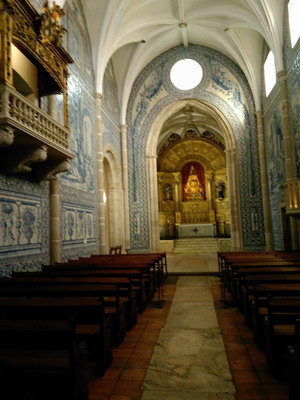
We passed the remains of a Roman Temple, used variously since the 2nd century as a temple for imperial worship, an armoury, theatre and slaughterhouse. The Convento dos Loios is today a posada (tourist inn) and a museum. The church is used only on special occasions and is gaspingly beautiful covered with blue tiles and an elaborate golden altar. An iron grille in the floor allowed a glimpse of the collection of bones and skulls in the basement. Portugal is overwhelmingly Catholic even today, but we saw many churches converted to museums.
The Se Cathedral is an impressive structure; its closely guarded
collection
of sacred art is truly fascinating. Amongst its collection was a
jewel-studded reliquary of the True Cross. Every time I guide at the
Holy Sepulchre in Jerusalem I recall that
many
churches have
pieces of theTrue Cross but this was the first time I saw one.
Unfortunately
no pictures were allowed. For those who have roots in South Africa, it
was here that Vasco da Gama's fleet was blessed before his sea voyage
to India, via the Cape of Good Hope.
And again we did cork shopping.
On the way back we drove along a severely rutted dirt road to Cromlech
of Alamendres – 95 large elliptical
stones situated in
rings that reminded us of Stonehenge. The stones are smaller but were
erected much earlier, even then dedicated to a solar cult.
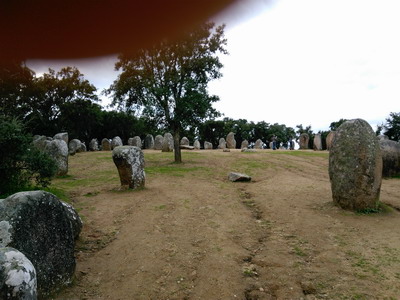
On our first night Rui and Connie had talked about cork. As we drove along the dirt road we were delighted to see groves of cork oak trees Quercus suber. We learnt that Dom Perignon is not only the name of the most famous champagne, but a monk who use the cork as a seal for wine. On the oak trees we could distincly see where the bark had been removed and the number of the year it was harvested painted on the trunk. A reddish trunk indicated that the bark had only recently been removed. The cork will regenerate itself and ten years later it will be again harvested. Removal of the bark does not harm the tree; in fact it promotes growth and prevents disease. Today thin layers of cork are backed with material and are used to make bags, raincoats, shoes as well as floor and insulating tiles, oil spill absorbants and heat shields. We were delighted to see feral pigs feeding on the acorns as they walked beneath the trees. Their meat is served in restaurants as black pork, a delicacy.
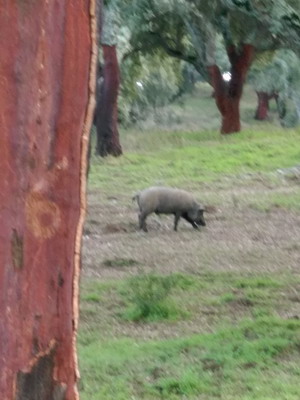
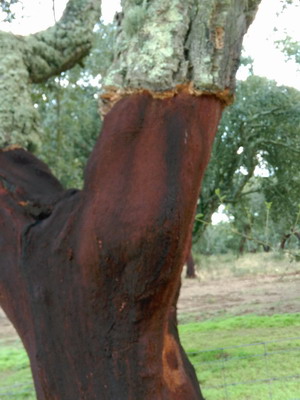
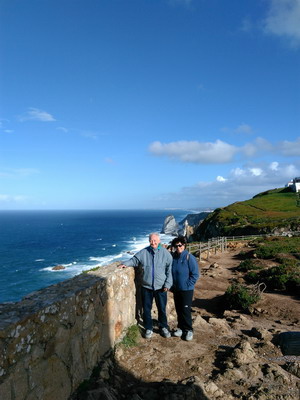
The next morning, with rain threatening, we drove northwards towards Cabo da Roca.
It is the most western point of the European continent. Braving the
cold and
the biting wind, we watched the waves of the Atlantic Ocean crash
against the
dramatic rocks below.
Having been to Cape Agulhas, the most southern point on the African
continent
where the Atlantic and Indian oceans meet and Mount Warning in
Australia
where the sun’s rays first reach the continent, we were happy to add
this to
our list of "most" points. (Unfortunately when we climbed Mount
Warning at night, the weather was so bad that it seemed the sun
didn’t
rise that day. What we did see was our legs covered with leeches! See what we wrote then.)
The mountain ridges on the way to Sintra
were dotted
with wind turbines. But there were also many old windmills, painted
white. We
may have been in Portugal but I kept an eye out for Sancho Panza.
In Sintra, spurning the bus service we
took a tuktuk driven by an informative
driver who assured us her
little vehicle would make it up the steep mountain to Palacio de Pena.
It did;
slowly. The palace is an exuberant collection of architecture and
decorative
styles built in the 19th century. It must have been
like
living in Disneyland. We thoroughly enjoyed exploring the castle.
Happily we
decided to photograph the Castelo dos Mouros from the Pena Palace
because the
rains started when we took another tuktuk
down the
steep hill back.
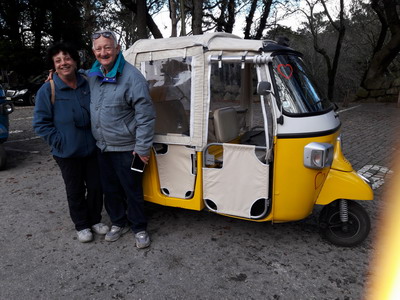
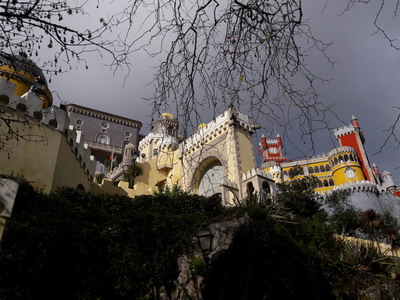
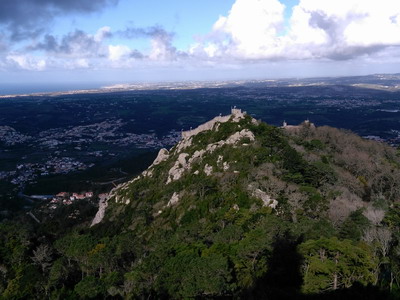
Our final stop for the day was at the delightful hill town of Obidos. Encircled by a wall and guarded by a tower the white houses with brown roof tiles clustered together looked enchanting. We first stopped for coffee and Pasteis de Belem, a delicious traditional egg tart. We then walked along the quaint streets, buying chocolate sardines, tasting cherry liqueur in little chocolate cups and eating excellent chestnuts roasted on the street. The rains came again so we hurried back to the car and made our way to Leira where we stopped for the night. In Leira we ate too much at an excellent fish restaurant. In Portugal, when you sit down at a restaurant the waiter immediately brings little appetizers: fried balls of fish, delicious rounds of cheese, sardine paste, bread etc. This will all be charged so if you don’t want it you are welcome to send it back. But if you, like us, come to the table very hungry, who can resist?
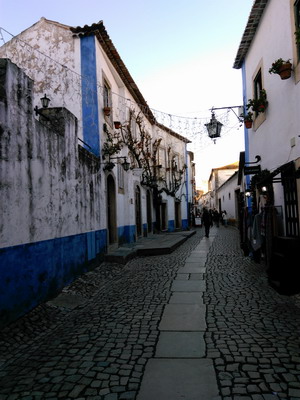
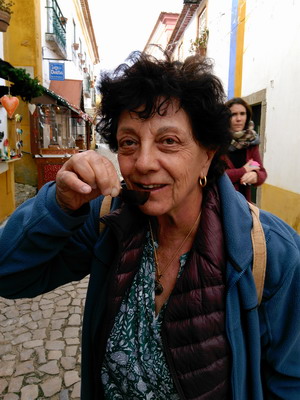
The next morning Eitan woke up with an awful toothache. He was most satisfied with the excellent emergency dental care he received. We also couldn’t believe that an examination, X-ray and prescription cost only Eu25. When ready we drove to Figueira da Foz. We found parking by the Mercado and went to explore. The market was housed in a building with rows of neat counters offering fruit, vegetables, flowers and nuts and all kinds of fish. What was remarkable was the orderliness and cleanliness of the whole place. A porter preparing to remove the fish (fish was taken away at noon while the other stalls remained open until 4.00pm) directed us to a fish restaurant Casarol 1. I had been dreaming of Portuguese sardines served on a red clay plate (memories of the Polano Hotel at Lourenzo Marques now Maputo, in Mocambique) but was informed that sardines were out of season and it was forbidden to catch them in winter. So we ate squid instead.
After lunch we made our way to Casa do Paco
to see the tiles. In the 1700’s when a boat was shipwrecked 7,000 tiles
were
salvaged, sorted and placed on the walls of an old house.
Although we
would call them Delft tiles, they were made in Rotterdam. The tiles are
in
three styles – landscapes, horsemen and women, and biblical scenes. The
tiles
are either in blue or brown. The young curator told us the stories
relating to
the tiles, including tiles placed upside down and those with special
markings.
With the memory of the Inquisition still on our minds we
were
surprised, and pleased, to see that there was an extensive exhibition
of how Figueira da Foz,
as well as other
towns in Portugal gave refuge to Jews during the Holocaust. Arisitides
de Sousa Mendes, a Portuguese consul to Bordeaux, issued thousands of
visas to refugees from France Jews and others, at great cost. He
was
subsequently fired and lost his pension. In 1966 he was deservedly
declared Righteous Among the Nations.
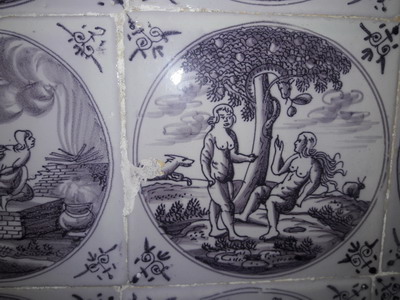
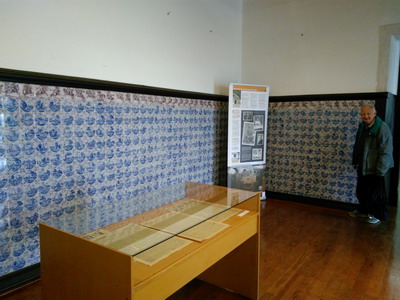
Our next stop was at Aveiro. We typed in an incorrect street name on the GPS but it was fortunate as it took us through an old area with houses picturesquely covered with tiles.
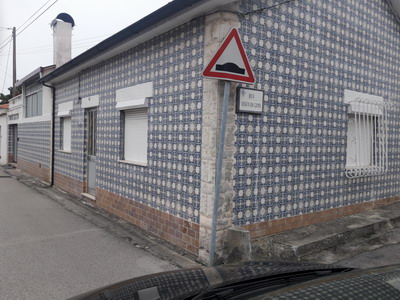
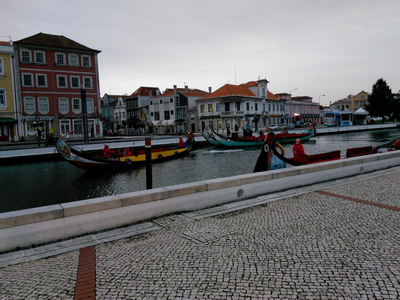
Finally reaching the town centre, we declined the urgings of young women to take a moliceiro boat ride along the canals in the freezing cold and instead walked to find a café. Together with our coffee we tried a local specialty Ovos moles de Aveiro. Small shell or barrel shaped casings made from flour and egg whites are filled with a cream made from egg yolks, sugar (lots) and water. It’s name can only be used in products made in the region
,
After that we drove to our hotel
in Porto along miles and miles of pine trees and eucalyptus in
plantations used
mainly for logging it seems.
16th December is our wedding anniversary, and today we celebrated our 52nd anniversary – no mean achievement. We decided on a more relaxing day and drove to the Duoro Valley Port Wine region.
For hours, the road snaked its way up and down hills all covered with narrow terraces on which the vines grow. Even private houses had their little vineyards. The British Taylors and Sandeman are very big producers of port but we didn’t want something we could buy back home. Instead we decided to stop at Quinta do Tedo, a spontaneous and fortunate choice. At the Quinta, Phillipa told us that their grapes are crushed the old way, by foot. We learnt about the different kinds of port and how they are produced. We tasted rose port – more like a wine and then ruby and tawny port. They latter two were very good, but when Phillipa learnt it was our wedding anniversary she took out a bottle of 20 year old tawny port for us to taste. It was delicious. Of course we bought a bottle and shall have to wait for an occasion to open it as it seems that port, like wine, has a very limited shelf life once opened.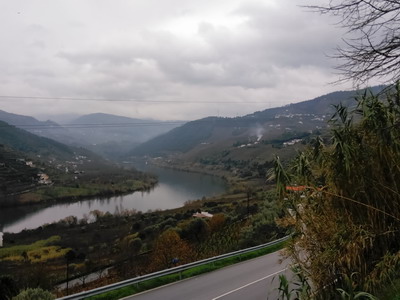
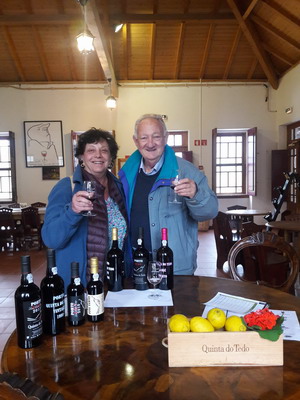
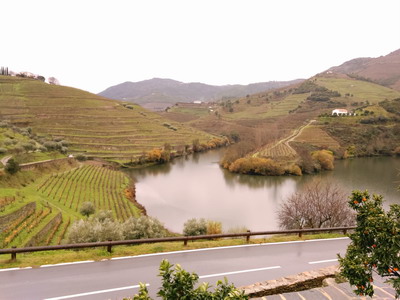
That evening to celebrate our anniversary we took a taxi to the 5 Oceanos Restaurant in Matosinhos, a village famous for its fish and seafood. It was a long way to go for seafood that was good but not amazing.
On our second day in Porto we woke to bright blue skies and no trace of rain. After breakfast we drove northwards to Viana de Castelo. We have become so accustomed to drive with either waze or a GPS, that when Eitan after looking at the road map suggested we make a little detour it seemed like a big adventure. Trying to get to Vila do Conde we found ourselves in Povoa de Varzim and were enchanted. There is a long promenade along the beach with fascinating statues. What caught our eye was a most expressive statue of a line of women holding their cache of fish and offering them for sale. The expressions were wonderful, reflecting pride, worry and just plain weariness. We spoke to a women who was bending and photographing the statue and surroundings from all angles and she told us to look for the actual women selling fish. We saw two old women with scarves on their heads sitting on stools by the entrance to the port., but their baskets were empty and they gestured that they were waiting for the catch to be brought in. There was a magnificent wall covered with azulejos, painted blue ceramic tiles, describing the life of the fishermen and their families. One panel, dated 1892, describes a fierce storm when boats sank as women watched from the shore. It was a very hard life. We backtracked to Vila do Conde to see the houses with their fronts tiled and again noticed that although the sea seemed calm enough where there were rocks, the sea raged.
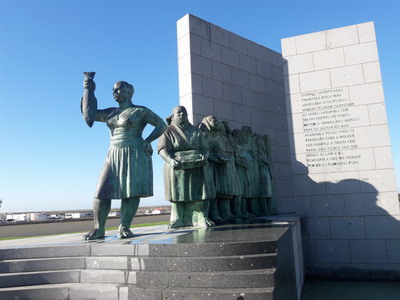
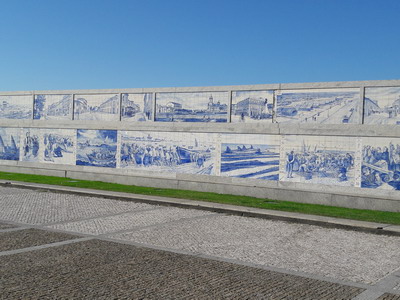
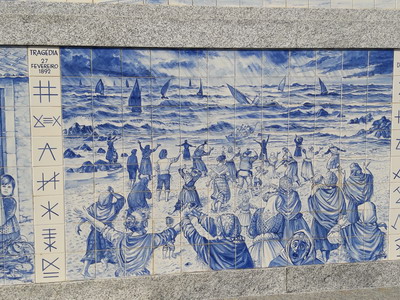
We continued to Viana de Castelo and walked around the old city, but we didn't find it particularly exciting. We drove back to Porto and while Eitan returned to the hotel I went to explore Porto.
.
It is a beautiful city with houses clustered together rising steeply on either side of the Duoro River. I took a taxi to Serra do Pilar for a good view of the city. The taxi went down a steep narrow road that wound between houses. It seemed there was hardly enough room for one vehicle only to find cars and a bus coming from the opposite direction. The Serra do Pilar is an army base with a great view of the city. I then joined the streams of visitors and walked across the bridge making my way to the Sao Bento train station. It is considered to be one of 15 most beautiful train stations in the world and compares favourably to the metro in Moscow. Again blue tiles but also colorful majolica tiles describing battles, feasts and modes of transport. I walked uphill to have coffee at the Majestic Cafe in the heart of the shopping area. It is a lovely old cafe in one of the town's busy streets. The coffee and cake were good, but people-watching before their Christmas shopping was even better, I asked the woman next to me what she was eating, because it looked very familiar. From her description I gathered it was a fancy french toast sitting in a bath of syrup - a traditional christmas dish. Everything in Porto entails a walk either up or down and by the time I had seen another church and the Se Cathedral my feet were aching. I crossed the bridge again to the other side of Porto and was enchanted by the view at sunset. I took a funicular ride down to Riviera by the river and then a taxi back to the hotel. For dinner we returned to the Riviera and went to Bacalhoeiro a recommended restaurant for bacalhau or salted cod. So pervasive is bacalhau in the Portuguese cuisine that there is no word for fresh codfish; it is called fresh salt cod. In keeping with the previous day's tour of the Duoro River I had cod in port wine while Eitan had cod loin. Both were excellent.
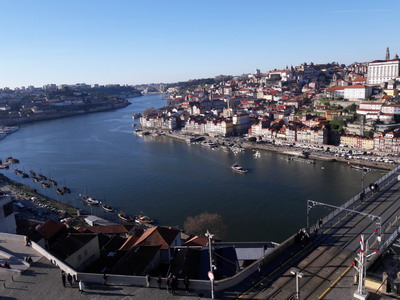
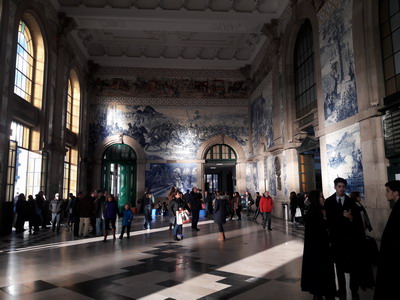
The next day we turned south stopping at Coimbra an ancient university town. We drove through torturously narrow streets up to Se Velha. a fortress cathedral, celebrating the Catholic victory over the Moors in 1064.
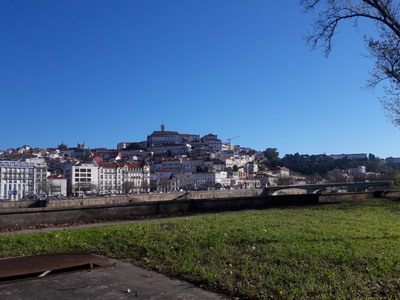
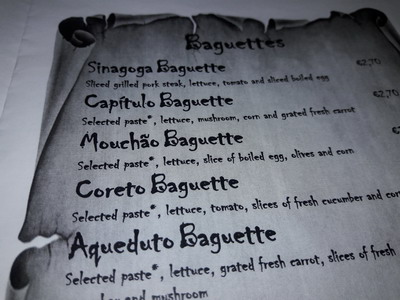
From there we drove to Tomar where we ate a very ordinary salad for lunch but topped it off with an excellent creme caramel. The restaurant named its dishes after the medieval attractions in the area. We were most amused to see that "Sinagoga Baguette" was made with grilled pork!
The visit to Convento de Cristo was well worth it. Founded by the Grand Master of the Templars in 1160 it is a massive complex of walls, dormitories, cloisters a manueline church and fabulous Charola. We admired the architectural embelishments decorating the outside walls, but the jewel of the visit was the Charola, the Templar's oratory. Supposed based on the original Rotunda of the Holy Sepulchre its soaring walls and umbrella-like ceiling were all covered with statues and paintings. The overall impression was breathtakingly beautiful and impressive.
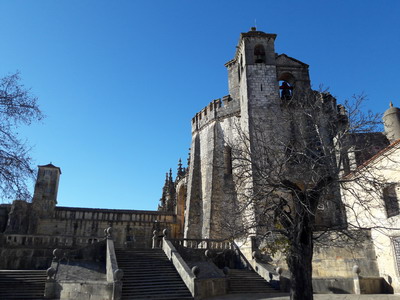
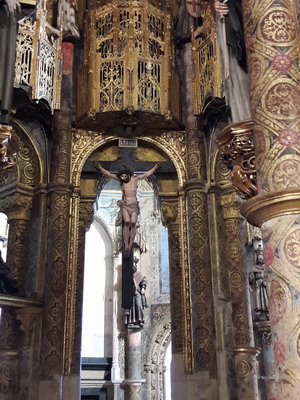
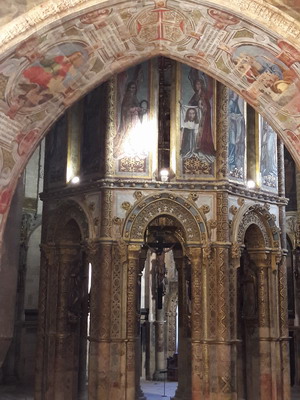
We then descended the hill to the narrow street of Rua Dr. Joaquim where the ancient synagogue founded in 1450 stands. Like in Spain the Jews were ordered to convert to Catholicism or leave, which they did in 1496. The building served variously as a prison, possibly a church, then a warehouse until the 1920 when it was declared a national monument. There are only two Jewish families in Tomar today and although the woman in the synagogue spoke no English or Hebrew she tried her best to make us understand. Curiously, in the corners of the high walls are ceramic jars, placed with their mouths towards the centre of the building. This was to amplify the sound in the building.
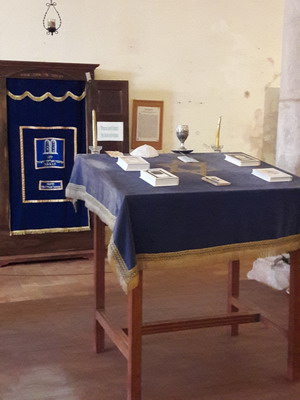
We spent the night at Hotel dos Templarios. Expecting a cold stone building with bare furnishing we were nonplussed to find ourselves in a luxurious hotel. Pity we didn't bring our swim suits... for the bath it was so deep!
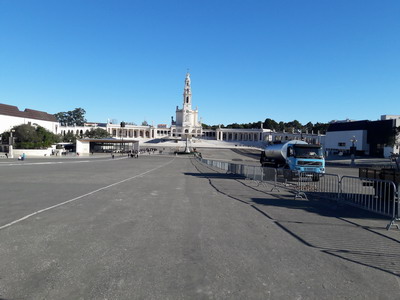
The following morning we visited Fatima.
It is a huge complex devoted to a young shepherd girl, Lucia, who in 1917 had repeated visions of Mary. Six months later when 70,000 adherents came with Lucia, hoping to have a similar vision, she was the only one who heard the words spoken of hell, of a war more terrible than WWI and of the assasination of a pope. The last two certainly became true. Lucia became a nun and died about 10 years ago. She and her two cousins who first saw the apparition of Mary in an oak tree near their home are all buried in the Basilica.
Within the complex is a huge church of the Holy Trinity that can literally seats thousands and a smaller chapel of the Apparition by the oak tree. Religion is based on faith, but this event is very real, a fact, to many Catholics and the Church has invested huge amounts to enable the faithfull to worship here.
From there we continued to Belem on the outskirts of Lisbon. Many museums are closed on a Monday. but my guidebook said the monastery of St Jeronimos was open. I was particularly keen to see the tomb of Vasco da Gama, who landed first in the Cape and then in Natal on his sea voyage of discovery to India in 1499, but the church was closed. It was a disappointment. We could only admire the manueline decorations from the outside.
We walked to the huge mosaic "wind wheel" donated by South Africa commemorating 500 years of the death of Henry the Navigator. He was not a sailor but a king who iniatiated the great voyages of discovery of the Portugese in the 15 and 16 centuries. We heard a guide telling a group that the sea explorer who first came to the Congo saw a river so wide that he returned and said he had found the tip of Africa. The impressive Monument of the Discoveries honoring those connected to the voyages was covered with scaffolding with no access to the tower. We tried to walk to the Tower of Belem but found a marina blocking our way. When we eventually got there, there was scaffolding on the tower as well, although we could admire the beautiful tower where monks could observe the ships as they set sail for unknown waters.
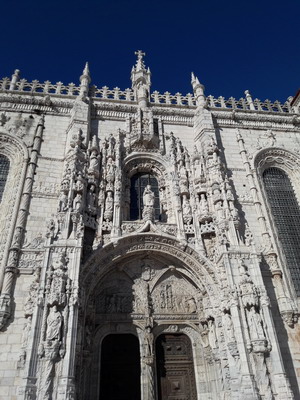
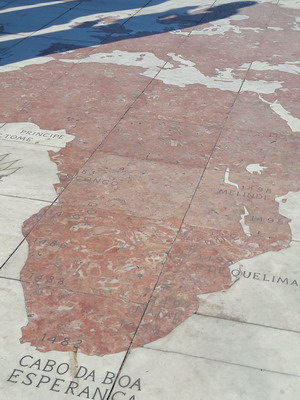
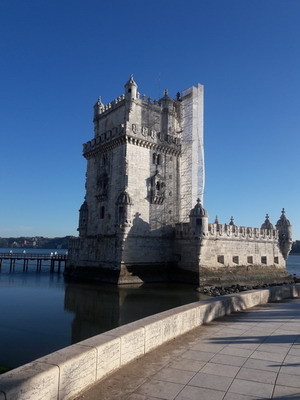
The last thing to do in Belem was to eat Pasteis de Belem, a custard tart with an incredible crunchy flaky pastry. Quite delicious.
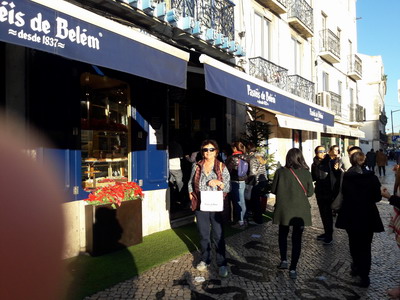
Then back to Caiscais and Connie and Rui. One of the few restaurants open on a Monday was a hamburger restaurant - excellent hamburgers with grown-up toppings..
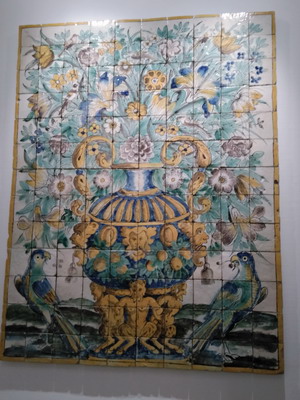
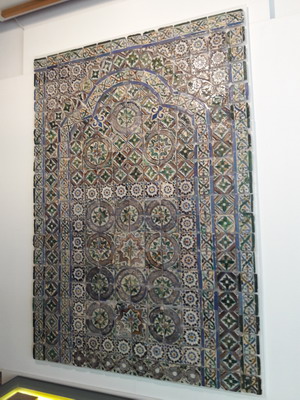
On our last day we went back to Lisbon to Museu National do Azulejo. the tile museum. Although quite a way out of Lisbon we felt that the tiles, patterned, tableaus, blue, brown or coloured were so much a part of our trip that this would be a fitting ending. There is a lot of road construction going on and our GPS had a hard time finding it. When we got to the museum there was no parking available anywhere. I noticed that the gate to the museum courtyard was open and there were a few cars parked inside the gates so I drove over the pavement and parked by the stately building. The museum was most interesting, explaing the development and styles of the tiles throughout the centuries. Essentially the tiles are a cheap way of painting and also of facing houses. The question remains why, even when Portugal was a wealthy empire, did the tiles continue to be developed and used extensively. When it came time to leave I saw that the iron gate of the museum was partially closed. With Anthony guiding me I managed to squeeze through the gate only to find the exit to the street blocked by iron guards locked into place. So we drove along the pavement until we found an opening and were on our way.
Lunch was an excellent experience at the Time Out Mercado. Tens of stalls lined the large eating area offering every kind of food. My fish and chips, Portugese style, was delicious, but it seems they haven't heard of ketchup! We then took a taxi to Elevador de Santa Justa, an old wooden elevator in an ornate iron grille structure that takes visitors up 32 meters and then a walk up a narrow spiral staircase to an excellent view of the city. We chose not to wait for the elevator down but instead walked from the upper level street down to the river front. We chanced upon a busy shopping street and were surprised at all the people walking up the steep hill to stores lining the streets. By the time we reached the bottom of the hill our knees were screaming and we began to understand why people chose to walk uphill!
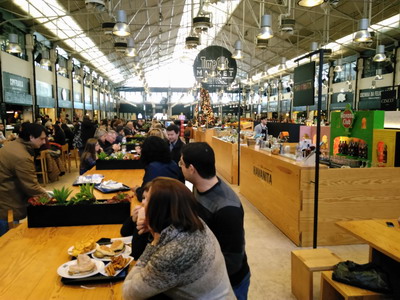
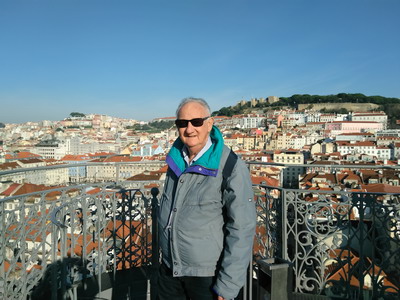
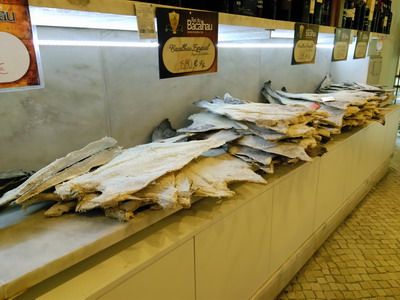 We also saw shops selling whole salted cod.
We also saw shops selling whole salted cod.
Our final dinner was also in Caiscais with Rui and Connie, at Moules & Co. The restaurant serves only mussels and gin. The mussels were plump and large and I loved the ginger and lemon grass they were cooked in. The gin was good too.
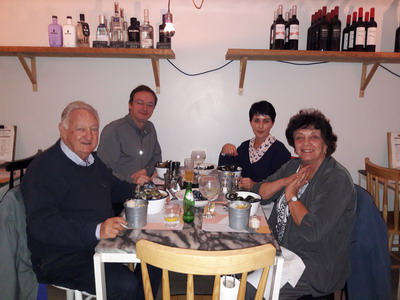
With our hosts, Connie and Rui
We spent 10 days in Portugal and found it full of surprises. We were there in winter so there were fewer tourists and the prices of hotels were attractive. We found that the people were friendly and literally went out of their way to explain or point us in the right direction. They are cosmopolitan, and almost everyone spoke. English. We were enchanted by the towns and villages and the beautiful coastal area. The highways were excellent although we heard that the local people can't afford the tolls and use the old roads. Besides the port wine we loved the cheeses. We could have stayed and seen and done much more.
.